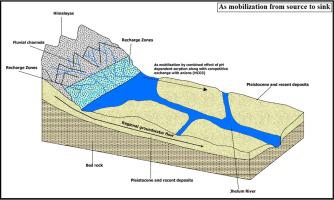当前位置:
X-MOL 学术
›
J. Hydrol.
›
论文详情
Our official English website, www.x-mol.net, welcomes your
feedback! (Note: you will need to create a separate account there.)
Sources and processes of groundwater arsenic mobilization in upper Jhelum basin, Western Himalayas
Journal of Hydrology ( IF 5.9 ) Pub Date : 2020-12-01 , DOI: 10.1016/j.jhydrol.2020.125292 Ghulam Jeelani , Suhail A. Lone , Amrin Un Nisa , Abhijit Mukherjee , R.D. Deshpande
Journal of Hydrology ( IF 5.9 ) Pub Date : 2020-12-01 , DOI: 10.1016/j.jhydrol.2020.125292 Ghulam Jeelani , Suhail A. Lone , Amrin Un Nisa , Abhijit Mukherjee , R.D. Deshpande

|
Abstract Arsenic (As) concentration in groundwater is one of the worst problems we are facing owing to its carcinogenic effect. The problem should therefore be addressed scientifically. Although groundwater Arsenic (As) enrichment is reported in many basins across the globe, still scientists have long way to go. In the present study we present new As data in groundwater to understand the processes and aquifer environment responsible for the As mobilization in groundwater of upper Jhelum basin, western Himalayas. The groundwater in the unconsolidated aquifers is less mineralized, with low electric conductivity, moderate pH and is mainly of Ca-Mg-HCO3 type. The results suggest that carbonate dissolution, silicate weathering and active cation exchange is controlling the ionic composition of groundwater. Arsenic (As) concentration in groundwater showed a wide range (0.14 µg L−1–192 µg L−1), with 45% of water samples having As >10 μg L−1 (WHO guidelines for drinking water). The shallow groundwater wells were more As enriched than deep groundwater wells. Groundwater As showed significant correlation with redox sensitive parameters including Fe, Mn, pH, NH4-N, HCO3− and poor correlation with NO3− and SO42−. Besides the lower slope (w.r.t. GMWL) and higher isotopic values (δ18O and δ2H), we observed a significant correlation of δ18O with As, EC and Cl− in shallow groundwater. The study suggests that the source of As is from quaternary deposits of unconsolidated aquifers with their provenance from the volcanic, sedimentary and metamorphic rocks of Himalayan orogeny. The As release from these quaternary deposits requires a proper and favorable aquifer environment.
中文翻译:

喜马拉雅西部上杰赫勒姆盆地地下水砷动员的来源与过程
摘要 地下水中的砷 (As) 浓度因其致癌作用而成为我们面临的最严重问题之一。因此,应该科学地解决这个问题。尽管全球许多盆地都报告了地下水砷 (As) 富集,但科学家们仍有很长的路要走。在本研究中,我们提供了地下水中的新 As 数据,以了解导致喜马拉雅山西部杰赫勒姆盆地上部地下水中 As 迁移的过程和含水层环境。松散含水层地下水矿化程度低,电导率低,pH值适中,主要为Ca-Mg-HCO3型。结果表明,碳酸盐溶解、硅酸盐风化和活性阳离子交换控制着地下水的离子组成。地下水中的砷 (As) 浓度范围很广(0.14 µg L-1–192 µg L-1),45% 的水样中砷 >10 µg L-1(世卫组织饮用水指南)。浅层地下水井比深地下水井富含 As。地下水 As 与氧化还原敏感参数(包括 Fe、Mn、pH、NH4-N、HCO3−)显着相关,而与 NO3− 和 SO42− 相关性较差。除了较低的斜率(wrt GMWL)和较高的同位素值(δ18O 和 δ2H)外,我们还观察到浅层地下水中 δ18O 与 As、EC 和 Cl− 的显着相关性。该研究表明,As 的来源是松散含水层的第四纪沉积物,其来源来自喜马拉雅造山带的火山岩、沉积岩和变质岩。
更新日期:2020-12-01
中文翻译:

喜马拉雅西部上杰赫勒姆盆地地下水砷动员的来源与过程
摘要 地下水中的砷 (As) 浓度因其致癌作用而成为我们面临的最严重问题之一。因此,应该科学地解决这个问题。尽管全球许多盆地都报告了地下水砷 (As) 富集,但科学家们仍有很长的路要走。在本研究中,我们提供了地下水中的新 As 数据,以了解导致喜马拉雅山西部杰赫勒姆盆地上部地下水中 As 迁移的过程和含水层环境。松散含水层地下水矿化程度低,电导率低,pH值适中,主要为Ca-Mg-HCO3型。结果表明,碳酸盐溶解、硅酸盐风化和活性阳离子交换控制着地下水的离子组成。地下水中的砷 (As) 浓度范围很广(0.14 µg L-1–192 µg L-1),45% 的水样中砷 >10 µg L-1(世卫组织饮用水指南)。浅层地下水井比深地下水井富含 As。地下水 As 与氧化还原敏感参数(包括 Fe、Mn、pH、NH4-N、HCO3−)显着相关,而与 NO3− 和 SO42− 相关性较差。除了较低的斜率(wrt GMWL)和较高的同位素值(δ18O 和 δ2H)外,我们还观察到浅层地下水中 δ18O 与 As、EC 和 Cl− 的显着相关性。该研究表明,As 的来源是松散含水层的第四纪沉积物,其来源来自喜马拉雅造山带的火山岩、沉积岩和变质岩。









































 京公网安备 11010802027423号
京公网安备 11010802027423号